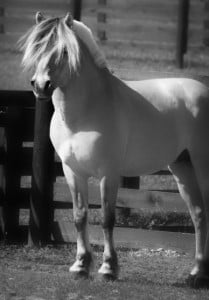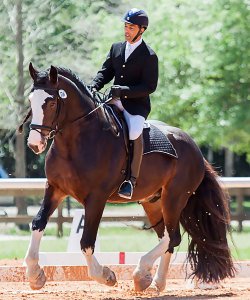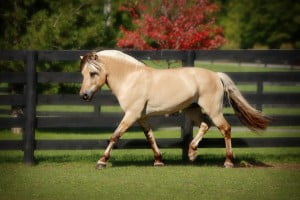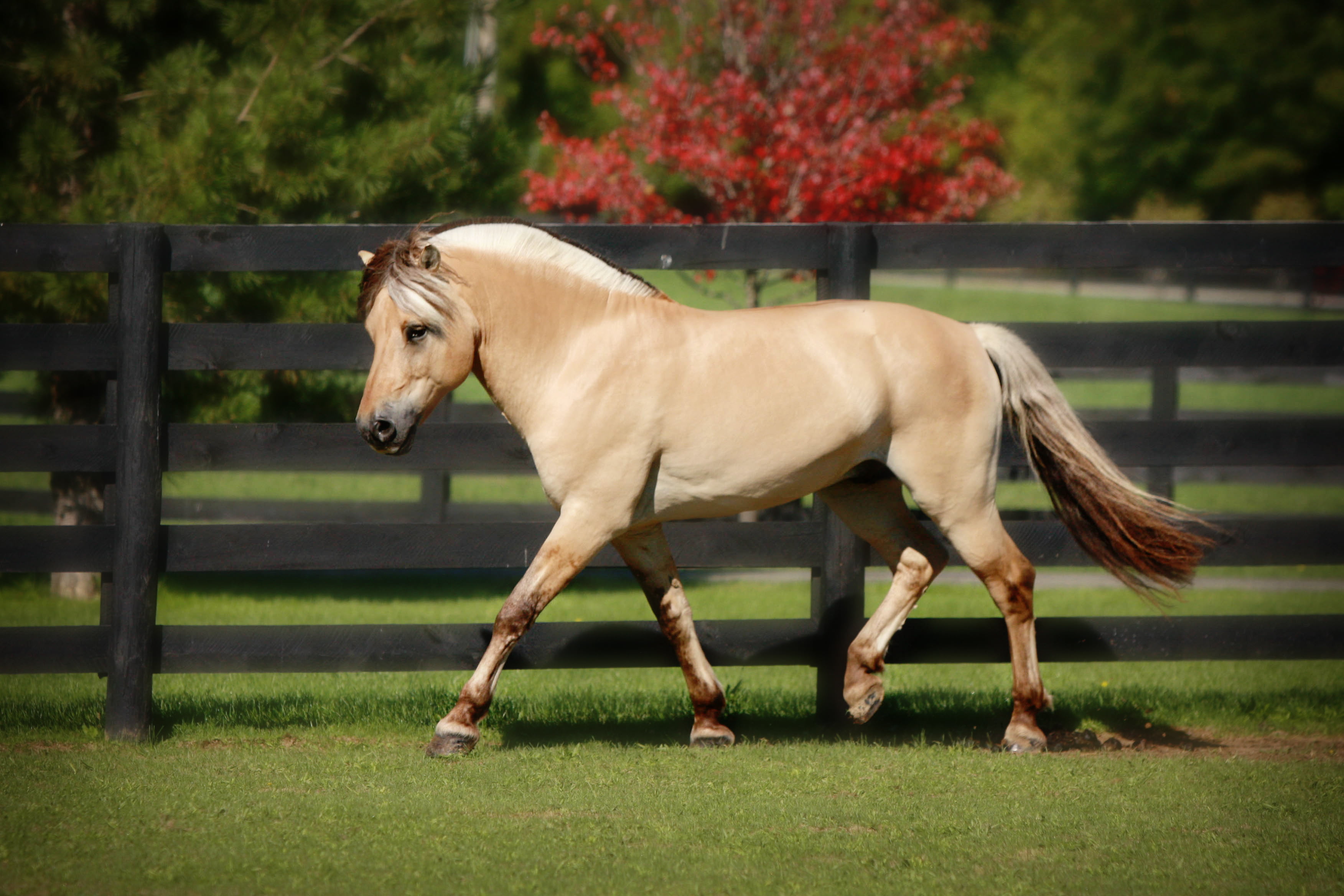Previously published in ‘The Fjord Herald’ Magazine – Winter 2014
(Part Three in a Three-Part Series)
Training and Exposure
By far the most straightforward route to a well-mannered, gentlemanly stallion is through consistent training and exposure to the world. As with any horse, progressively introducing him to different environments, circumstances and venues such as shows, parades, trail rides, fairs and exhibitions, builds confidence when approached correctly.
 Stallions require an additional element of planning when it comes to public events as you must always be aware of other horses and of humans who may approach your horse and assume he is as benign as he appears. Being aware of your surroundings and planning how and where you might create some space for your horse should it become necessary is essential. In extremely crowded situations, such as a State Fair might present, it is a good idea to have a walker accompany you when your horse is away from his stall, just in case you need someone to create a path for you or to warn other exhibitors that your horse is a stallion as many people do not realize that your doe-eyed pony can become a huffing, puffing fire-breathing dragon in certain circumstances.
Stallions require an additional element of planning when it comes to public events as you must always be aware of other horses and of humans who may approach your horse and assume he is as benign as he appears. Being aware of your surroundings and planning how and where you might create some space for your horse should it become necessary is essential. In extremely crowded situations, such as a State Fair might present, it is a good idea to have a walker accompany you when your horse is away from his stall, just in case you need someone to create a path for you or to warn other exhibitors that your horse is a stallion as many people do not realize that your doe-eyed pony can become a huffing, puffing fire-breathing dragon in certain circumstances.
With a young stud colt, and most especially with a mature stallion who lacks exposure at different venues, these experiences need to occur in the presence of an confident handler and preferably one who has an established, respectful relationship with the horse. It is critical during this time to never allow him to bend the rules. He should not be allowed to nudge, nibble or crowd you even when he is unsure of what is expected of him. As you progress to situations that are more stressful (such as mares or other stallions in proximity while he is working) strong foundational training will help to ensure you can recapture his attention regardless of the stimuli at hand. If you are planning to use your stallion for live cover in-hand, this is absolutely critical. (Note: live cover in-hand can be extremely dangerous to handlers and should only be attempted by experts or veterinary professionals.) The more frequently he can be exposed to other horses while working, the more consistent his ability to remain focused on his job will become until such time as he understands that when the tack goes on, it’s all business. It is certainly not too much to expect a stallion to share a ring with other horses and remain on his best behavior – but this does not happen overnight and takes a commitment to consistent, correct training to achieve it. Placing him in a show environment when he has not been off his farm in years is not fair to the horse or the other competitors who may suffer the consequences of his misbehavior.
 With four stallions on site, we regularly work them at the same time and occasionally will test them by placing them in close proximity to each other during work. Or, we’ll work one while another is at liberty next to the arena and is generally encouraging lots of misbehavior. I find that allowing the stallions to express themselves vocally can help relieve tension during work – so long as they remain focused and respond to what is being asked of them. Thus, I only correct ‘talking’ when it is accompanied by disobedience. We also work them in the proximity of mares, geldings, foals and horses they are unfamiliar with as regularly as possible to keep their work ethic fresh and to reinforce the idea that the rules remain consistent regardless of the situation at hand.
With four stallions on site, we regularly work them at the same time and occasionally will test them by placing them in close proximity to each other during work. Or, we’ll work one while another is at liberty next to the arena and is generally encouraging lots of misbehavior. I find that allowing the stallions to express themselves vocally can help relieve tension during work – so long as they remain focused and respond to what is being asked of them. Thus, I only correct ‘talking’ when it is accompanied by disobedience. We also work them in the proximity of mares, geldings, foals and horses they are unfamiliar with as regularly as possible to keep their work ethic fresh and to reinforce the idea that the rules remain consistent regardless of the situation at hand.
Additionally, traveling with stallions becomes much easier when they are brought into contact with each other and with other horses (both mares and geldings) on a regular basis. There are few things more terrifying than an all-out brawl taking place in a moving trailer and the more exposure he has to his barn mates, the less of an event sharing the trailer with them becomes. To acclimate them for showing season, which arrives at the same time as breeding season in our area of the country, we move the stallions that will be traveling into adjacent stalls where they are separated only by the stall grills so that they can communicate physically but still remain safe. The adjustment period is usually a matter of hours and on travel day we find that we have one less thing to worry about when the time comes to load the trailer and get on the road.
 This type of training is beneficial to the stallions, obviously, as it provides mental stimulation for them. But perhaps more importantly, it produces a consistently well-behaved, safer horse that is, in the eye of the uneducated public, an excellent ambassador for his farm and breed. Should you find that you must sell such a horse, there are far more eligible buyers for a stallion that is easily handled, and his emotional value goes up exponentially. Barn life in general is far easier when a trip to a show is rendered a ‘non-event’ due to diligent training and exposure.
This type of training is beneficial to the stallions, obviously, as it provides mental stimulation for them. But perhaps more importantly, it produces a consistently well-behaved, safer horse that is, in the eye of the uneducated public, an excellent ambassador for his farm and breed. Should you find that you must sell such a horse, there are far more eligible buyers for a stallion that is easily handled, and his emotional value goes up exponentially. Barn life in general is far easier when a trip to a show is rendered a ‘non-event’ due to diligent training and exposure.
In a perfect world, only the finest specimens of horse would remain intact for breeding. Regardless of his breeding and conformation, if you are intent upon keeping your horse a stallion, it is critical to perform an honest assessment and ask yourself, “Do I possess the financial resources, physical resources, skill, and time to commit to creating a safe, gentlemanly horse? Would the job (discipline) I have chosen for him and his value be more secure if he were a gelding? Can I promise myself that he will not end up living his life as a solitary creature in dark, corner stall?” As owners and enthusiasts of such a unique breed, we are called upon to make the right choice for these horses and to do everything possible to ensure the next generation inherits the best of their traits. I hope this article has provided some insight regarding how that may be done.
Tags: showing stallions, stallion management, stallion training
Barb Belknap
Thank you for the excellent articles on stallion management. They are packed with relevant information and are well written! Barb